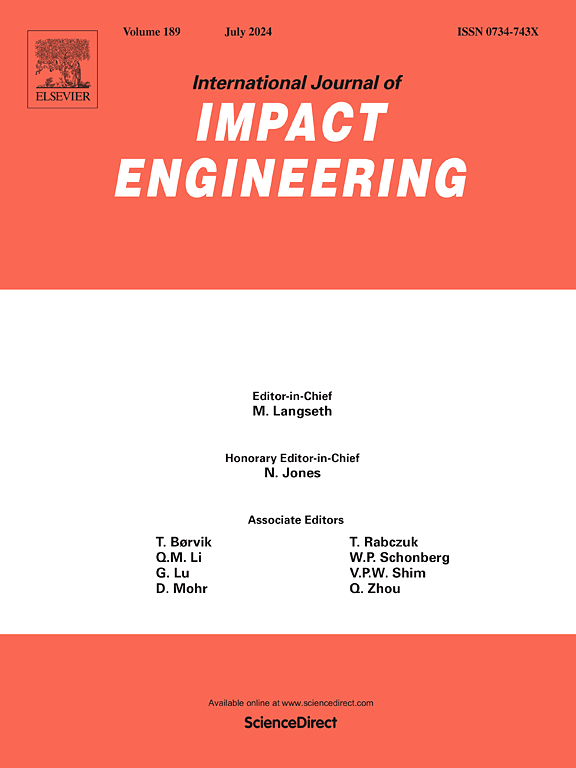Effects of surface topography on the crater formation process of rubble-pile asteroids
IF 5.1
2区 工程技术
Q1 ENGINEERING, MECHANICAL
International Journal of Impact Engineering
Pub Date : 2025-03-24
DOI:10.1016/j.ijimpeng.2025.105325
引用次数: 0
Abstract
High velocity impact experiments were conducted on a conical shaped sand target, simulating a large-scale cratering formed in gravity-dominated regime, which could be affected by a surface topography such as curvature of bodies. The target material consists of dry quartz sand, prepared in conical shape with its vertex angle 120° A spherical Al projectile with its diameter of 2 mm was impacted vertically on the top part of a cone at the velocity from 1 to 4 km/s. After the impact, a top part of the conical target was excavated to form a shallow bowl-shaped crater on the top. The target resembled a trapezoid when observed from the side. The crater rim radius was able to be scaled by a conventional π-scaling relationship although it's radius was about 10 % smaller than that of the crater formed on semi-infinite flat surface. This might be caused by the geometrical effect of the target. The ejecta opening angle was measured at the time of crater formation and it was about 130°, where this is larger than that of the ejecta curtain, <90°, formed over the target of semi-infinite flat surface. This wider ejecta opening angle on conical target was able to be well reproduced by utilizing the Maxwell Z-model to a conical target.
地表地形对碎石堆小行星陨石坑形成过程的影响
在锥形沙靶上进行了高速撞击实验,模拟了在重力主导下形成的大型弹坑,该弹坑可能受到物体曲率等表面地形的影响。将直径为2mm的球形铝弹以1 ~ 4km /s的速度垂直撞击圆锥体顶部,并将靶材制备成顶角为120°的锥形干燥石英砂。撞击后,锥形目标的顶部被挖掘,在顶部形成一个浅碗状的陨石坑。从侧面观察,目标象一个梯形。与半无限平面上形成的环形山相比,环形山的半径要小10%左右,但环形山的半径可以用传统的π-标度关系进行标度。这可能是由目标的几何效应引起的。在陨石坑形成时测得的喷射物开口角约为130°,比在半无限平面靶上形成的喷射物幕(90°)大。利用麦克斯韦z -模型可以很好地再现锥形靶上较宽的射开角。
本文章由计算机程序翻译,如有差异,请以英文原文为准。
求助全文
约1分钟内获得全文
求助全文
来源期刊

International Journal of Impact Engineering
工程技术-工程:机械
CiteScore
8.70
自引率
13.70%
发文量
241
审稿时长
52 days
期刊介绍:
The International Journal of Impact Engineering, established in 1983 publishes original research findings related to the response of structures, components and materials subjected to impact, blast and high-rate loading. Areas relevant to the journal encompass the following general topics and those associated with them:
-Behaviour and failure of structures and materials under impact and blast loading
-Systems for protection and absorption of impact and blast loading
-Terminal ballistics
-Dynamic behaviour and failure of materials including plasticity and fracture
-Stress waves
-Structural crashworthiness
-High-rate mechanical and forming processes
-Impact, blast and high-rate loading/measurement techniques and their applications
 求助内容:
求助内容: 应助结果提醒方式:
应助结果提醒方式:


